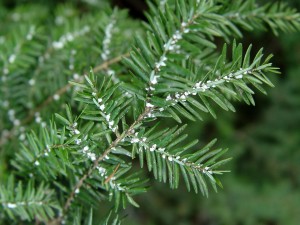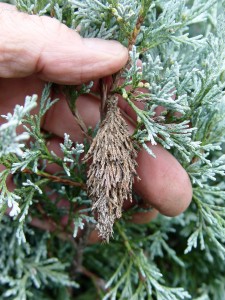Don’t Kiss Those Stinkbugs Goodbye Yet
March 12th, 2014
Gardeners and non-gardeners alike have been hailing the social-media-fueled reports about one of the winter of 2013-2014’s few bright spots – the freezing death of 90 percent of those annoying stinkbugs. 
Trouble is, reports of their death have been greatly exaggerated.
Though our polar-vortexy winter likely knocked back the population of this imported, indoor/outdoor pest, stinkbugs aren’t all stinked out.
Penn State University ornamental entomologist Greg Hoover says a 50-percent knockback is more realistic.
That’s nothing to sneeze at (unless you’re allergic to stinkbugs), but even 50 percent of this prolific bug is a lot left to eat our tomatoes and fly around our kitchen lights in winter.
The 90-percent-kill-rate story quickly made the social-media rounds – and much of the mainstream media as well – based on research from Virginia Tech University in Blacksburg, Va.
As he’s done for the last three years, Virginia Tech entomology professor Dr. Thomas Kuhar gathered colonies of captured stinkbugs and placed them in foam-insulated buckets outside to monitor how well they fare in varying winter conditions.
In a typical winter, 20 to 25 percent of the bucket-dwelling stinkbugs kick the bucket in Blacksburg.
During the winter of 2013-14, though, Kuhar found a death rate of 90 to 95 percent – likely due to the significantly colder January and February temperatures.
Somehow, that specific finding spread into the belief that 90 percent of stinkbugs in general died over the winter.
For one thing, other researchers haven’t been finding that high of a kill rate.
For another, plenty of stinkbugs are safely tucked away in more protected outside spots or in even warmer spots inside our homes, waiting for spring to head back outside to feast and mate.
“In protected locations like boxes in my attic, stinkbugs survived the polar vortex,” wrote entomologist Dr. Michael Raupp, the University of Maryland’s “Bug Guy,” in his entertaining Bug of the Week blog.
“Clearly, my home and many others provided sufficient refuge for the brown marmorated stinkbug to escape the thermal massacre,” Raupp says.
“If insects have the ability to prepare for winter,” says Hoover, “or if they can get into voids and leaf litter so their cells won’t freeze, they’ll do quite nicely.”
Raupp, Hoover and Rutgers University entomologist Dr. Anne Nielsen all suspect we’ll see a significant “beat-down” in the stinkbug population this season, but anything approaching 90 percent is unlikely.
Even Kuhar doesn’t claim his finding translates into a more general 90-percent stinkbug kill.
Far less reported has been his observation that outdoor-exposed stinkbugs can suffer worse in erratic winters than in one that’s consistently cold like this one.
The reason is that like plants, many bugs have the ability to gird themselves for cold temperatures by producing anti-freeze-like chemicals that prevent their cells from freezing and rupturing.
They also go into a state called “diapause” that’s somewhat akin to animal hibernation.
When it gets cold and stays cold, these winter-survival mechanisms help bugs stay alive during normal winters.
The bugaboo is when winter temperatures get abnormally warm for abnormally long periods of time, faking the bug’s anti-freeze system into “thinking” the coast is clear.
Then when a cold blast returns, the bug is less protected and more apt to croak – even at the same temperature it might have survived when fully prepared.
Predicting exactly how any bug population is going to fare at this point is somewhat of a crap shoot anyway, says Hoover.
Multiple variables are at play.
One is how cold it got for how long. That can vary significantly, not only from region to region but even in different locations in the same yard.
A bed next to a south-facing stone wall, for example, can be 5 or 10 degrees warmer than a bed out in the open in a frost pocket.
And while Harrisburg was getting down to zero degrees or slightly below, regions to the north and west of State College dropped down to 15 to 20 degrees below zero.
Sometimes a few degrees’ difference is enough to make the difference between bug survival and bug demise, Hoover says.
“I think desiccating (drying) winds also contribute to insect mortality,” he adds.
Different bugs also tolerate differing lows.
This winter likely knocked back the northward spread of the kudzu bug, a stinkbug-like pest that had made its way as far north as Maryland.
On the other hand, the emerald ash borer seems to do fine at zero degrees but suffers greatly at 20 below. At 30 below, it really gets zapped.
“Each bug has its own genetic makeup and cold threshold, and that varies from one species to another,” says Hoover. “The bottom line is that in the world of insects, due to their diversity, one size does not fit all.”
That means we’re going to have to wait and see exactly how this winter shakes out on a bug-by-bug, place-by-place basis.
Most entomologists are thinking the biggest hit is going to be to bugs that are soft-bodied and most exposed to cold temperatures and frigid winds.
A leading example is the hemlock woolly adelgid, a chlorophyll-sucking bug that spends the winter on hemlock needles. It’s a pest that’s been deadly to hemlocks – especially in forests – in the last 10 years.
Hoover says winter apparently killed enough of those that researchers are bemoaning the fact that they can’t find enough live adelgids to study.
“Adelgids are really going to take a nosedive,” he says. “It might be two or three years before we see treatable infestations again.”
You might therefore check or have your tree professional evaluate the health of adelgids on your hemlocks before automatically treating them this year.
Another bug that likely suffered this winter is the gypsy moth, the bug whose voracious caterpillar stage defoliates whole stands of hardwood trees.
Hoover says ones that managed to find shelter under rocks, pavers and snowpack likely survived, but ones with egg masses exposed to the elements – especially in Pennsylvania’s colder regions – likely did not.
On the other hand, Hoover suspects bugs such as ticks went largely unfazed. They’re pretty good at finding semi-decayed “duff” and other warm protectors over winter.
Emerald ash borers also likely suffered minimal mayhem.
“I’m sure we’ll see some mortality of the emerald ash borer but not like adelgids and gypsy moths,” Hoover says.
As for bagworms – a bug that feeds on evergreens in general and arborvitae in particular – those are up in the air (literally and figuratively).
Their cone-like sacs are exposed on branches to the environment with eggs inside, but apparently no one has done a survivability study on them yet.
Bagworms had a banner year in 2013, so any help from Mr. Vortex would be welcome.
We’ll see.
(For more on winter damage in the landscape, check out the piece I wrote on “Healing Your Winter-Damaged Yard” and another one on salt damage to plants.)









